NASA Captures Active Volcano Erupting on Jupiter's Moon Io
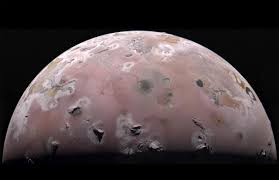
- 14 Dec 2024
In News:
NASA has revealed new details about Io, Jupiter’s third-largest moon and the most volcanic world in our solar system.
Overview:
- NASA’s Juno mission has revealed new insights about Io, Jupiter's third-largest moon, known as the most volcanic world in the solar system.
- Io has over 400 active volcanoes, which send plumes and lava flows into space, creating its unique, fiery surface.
Recent Discoveries and Observations:
- Fiery Heart of Io:
- NASA's Juno mission has helped solve a 44-year-old mystery regarding Io’s volcanic activity, revealing that its volcanoes are likely powered by separate magma chambers rather than a single large magma ocean.
- This discovery was made during Juno’s close flybys in late 2023 and early 2024, using Doppler measurements and precise gravity data to understand the moon’s interior.
- Volcanic Activity:
- Io's volcanoes constantly erupt, spewing lava and plumes that shape its surface. The volcanic activity was first observed by NASA's Voyager 1 spacecraft in 1979.
- Tidal Flexing: Io experiences constant squeezing due to its elliptical orbit around Jupiter, which generates immense internal heat and causes frequent eruptions.
- Scientific Insights:
- The research suggests that tidal forces from Jupiter do not create a global magma ocean inside Io, as previously thought, but instead lead to localized magma chambers that fuel its volcanoes.
- Tidal flexing is the primary cause of the immense internal energy on Io, which melts portions of the moon's interior and drives volcanic activity.
- Broader Implications:
- Understanding Other Moons and Exoplanets: Juno's findings have broader implications for understanding the interiors of other moons like Enceladus and Europa, and even exoplanets and super-Earths.
- Future Missions:
- Juno will continue its mission, with the next close approach to Jupiter scheduled for December 27, 2024, bringing it 2,175 miles above Jupiter's cloud tops. Since entering Jupiter’s orbit in 2016, Juno has traveled over 645 million miles.
Boeing Starliner
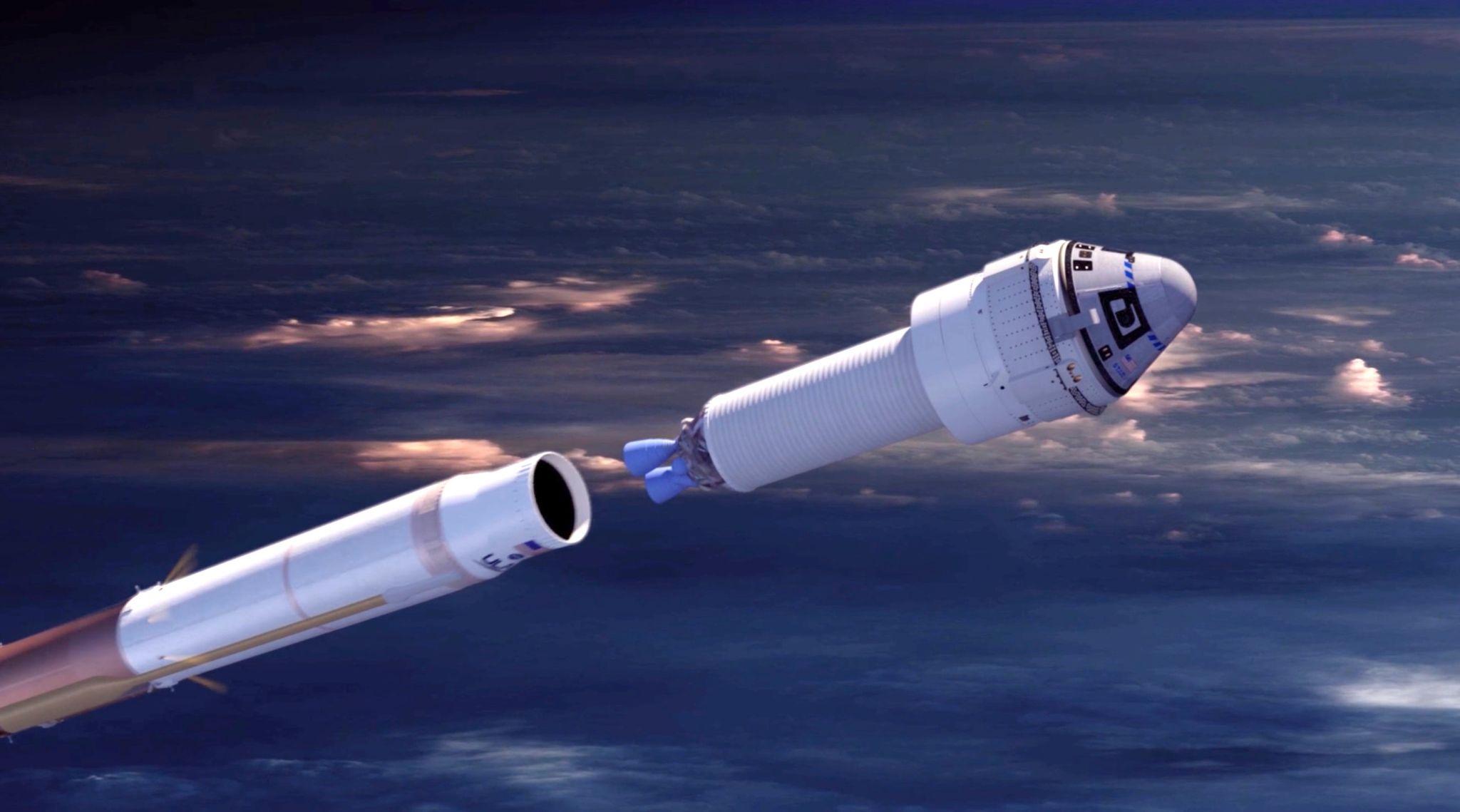
- 06 May 2024
Why is it in the News?
Boeing’s Starliner spacecraft, carrying two NASA astronauts, will be launched by an Atlas V rocket from the Kennedy Space Center in Cape Canaveral, Florida, to the International Space Station (ISS).
What is Boeing’s Starliner?
- Starliner, a reusable spacecraft, has a pusher abort system.
- This allows the crew to safely escape throughout the launch and the ascent phases of the mission.
- In addition to being software-driven, the Starliner has wireless internet that will help with “crew communication, entertainment and docking with the International Space Station”
- The spacecraft can fly and course-correct on its own.
- It operates like advanced self-driving cars, with features similar to sophisticated cruise control and hands-free driving, allowing astronauts to simply enjoy the ride without intervention.
- It also allows astronauts to choose their level of control.
- Consisting of a crew capsule and a service module, the Starliner aims to revolutionize space travel with its advanced features and capabilities.
Crew Capsule:
- The crew capsule is the heart of the spacecraft, providing housing for astronauts during their journey.
- Designed to withstand the rigours of reentry, the capsule ensures a safe return to Earth for its occupants.
Service Module:
- The service module is equipped with essential systems for astronaut survival, such as air and temperature control, water supply, and sanitation facilities.
- Additionally, it contains the necessary engines and fuel required for manoeuvring the spacecraft in space.
- This module is not reusable and is designed for single use.
Starliner Specifications:
- With a width of over 4 meters, the Starliner can accommodate up to seven astronauts at once.
- The spacecraft boasts a unique weldless structure, making it both durable and reusable, with a potential for up to 10 missions and a six-month turnaround time between launches.
- Furthermore, the Starliner incorporates modern technologies like wireless internet and tablet interfaces for enhanced crew interaction.
Launch Vehicle:
- The Starliner is compatible with the Atlas V rocket, operated by United Launch Alliance (ULA), a joint venture between Boeing and Lockheed Martin.
- This collaboration ensures the seamless integration of the spacecraft and launch vehicle, optimizing mission success.
Why is the mission significant?
- In 2014, NASA selected Boeing and SpaceX to develop spacecraft for transporting astronauts to the International Space Station (ISS).
- While SpaceX has already conducted multiple successful missions with its Dragon crew capsule, the Starliner's success would mark the first time the United States has two domestically produced spacecraft capable of carrying astronauts to space.
- Once operational, Boeing and SpaceX will alternate missions to the ISS, with each crew's expedition lasting up to six months.
- This partnership will continue until the ISS is decommissioned in the next decade.
X-Class Solar Flares

- 30 Mar 2024
Why is it in the News?
Recently the Earth was hit by an X-class solar flare that was strong enough to ionize part of the planet's atmosphere.
What are Solar Flares?
- Solar flares are large explosions from the surface of the sun that emit intense bursts of electromagnetic radiation.
- The intensity of the explosion determines what classification the flare belongs to.
- The most powerful are X-class flares, followed by M-, C-, and B-class; A-class flares are the smallest.
- These flares can be visible as bright flashes in a particular region of the sun and can last several minutes.
- Solar flares occur when magnetic energy builds up in the solar atmosphere and is released suddenly.
- These outbursts are intrinsically linked to the solar cycle — an approximately 11-year cycle of solar activity driven by the sun's magnetic field.
What Causes Solar Flares?
- The sun's surface is a magnetically mixed-up place.
- Magnetic fields are created from electrically charged gases generating electrical currents that act as a magnetic dynamo inside the sun.
- These magnetic fields twist, tangle, and reorganize themselves due to the turbulent nature of the gases that create them.
- This unsettled magnetic field behavior — also known as solar activity — can trigger solar flare eruptions from the surface that release vast amounts of electromagnetic radiation — a form of energy that includes radio waves, microwaves, X-rays, gamma rays, and visible light.
- Solar flares tend to originate from regions of the solar surface that contain sunspots — darker, cooler portions of the solar surface where magnetic fields are particularly strong.
- As such, the number of sunspots can indicate the likelihood of a solar flare eruption.
- Solar activity follows an approximately 11-year cycle with the peak of sunspot activity coinciding with the solar maximum and a sunspot hiatus coinciding with the solar minimum.
- During periods of low solar activity when no sunspots are present, it is unlikely that a solar flare will occur.
What are X-Class Solar Flares?
- Solar flares are categorized into five classes based on the intensity of emitted X-rays, with each class letter denoting a 10-fold increase in energy output, akin to the Richter scale for earthquake strength assessment.
- X-class flares are the most powerful solar flares.
- Then there are M-class flares that are 10 times smaller than X-class flares, then C-class, B-class, and finally A-class flares which are too weak to significantly affect Earth.
- Within each letter class, a finer scale from 1 to 9 gives the flare assessment greater precision with larger numbers representing more powerful flares within the class.
- However, X-class flares can break this nine-point rating mold with higher ratings, since there is no class more powerful than X-class.
- Fortunately, X-class flares occur on average about 10 times per year.
How do Solar Flares Affect the Earth?
- Disruption of Satellite Communications: Solar flares can interfere with satellite communications, GPS signals, and radio transmissions, causing disruptions or blackouts in telecommunications and navigation systems.
- Auroral Displays: Intense solar flares can trigger colorful auroras, or Northern and Southern Lights, as charged particles interact with Earth's magnetic field, creating stunning light displays in the polar regions.
- Power Grid Disturbances: Severe solar flares have the potential to induce geomagnetic storms that can overload power grids, leading to widespread power outages and damage to electrical infrastructure.
- Radiation Hazards: Solar flares emit harmful radiation, particularly in the form of ultraviolet and X-rays, which can pose risks to astronauts in space and airline passengers at high altitudes.
- Impact on Electronics: The influx of charged particles during solar flares can induce currents in electrical circuits, potentially damaging or disrupting sensitive electronic devices, such as computers, satellites, and spacecraft.
NASA Recently Shared a Satellite Image of Deception Island (Tribune India)
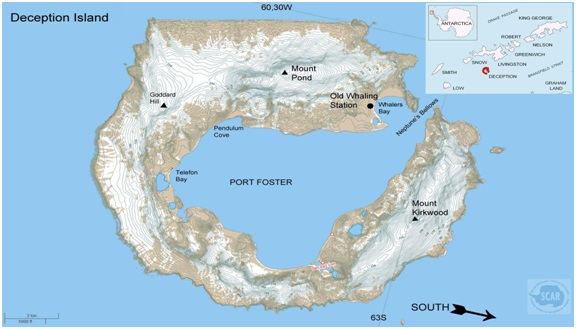
- 11 Oct 2023
Why in the News?
National Aeronautics and Space Administration (NASA) recently shared a satellite image of Deception Island, one of the only places in the world where a ship can sail directly into the centre of an active volcano.
About Deception Island:
- Deception Island is situated within the South Shetland Islands, forming part of an archipelago northwest of the Antarctic Peninsula.
- This volcanic island is notable for its dynamic features and distinct geography.
- Originating from a colossal volcanic eruption, Deception Island's formation resulted in the collapse of its central structure, allowing seawater to inundate the resulting caldera.
- The landscape is characterized by desolate volcanic slopes, steaming beaches, and glaciers adorned with ash layers, creating a unique horseshoe-shaped entrance to the sea via Neptune’s Bellows.
- The island encircles Port Foster, recognized as one of the safest harbours in the Antarctic, offering vessels a rare opportunity to navigate into the heart of an active volcano.
- Among the few places globally where this is possible, Deception Island has experienced over twenty eruptions since the 19th century.
- Notably, the island witnessed three volcanic eruptions from 1967 to 1970, leading to the destruction of Chilean and British stations.
- Presently, Argentina and Spain maintain summer scientific stations on the island.
- Deception Island is safeguarded under the Antarctic Treaty, designating it as a protected area with restricted human visits and minimized environmental impact.
Atmospheric Perturbations around the Eclipse Path (APEP) mission (HT)
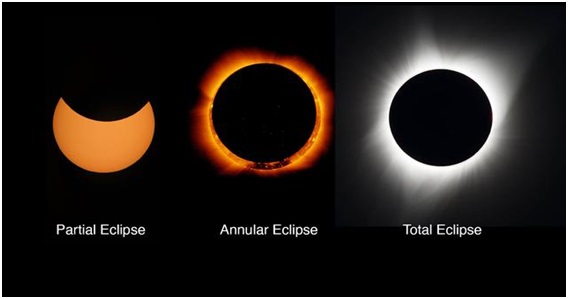
- 07 Oct 2023
Why in the News?
Dr Aroh Barjatya, an Indian-origin scientist is set to lead the multi-institution NASA rocket mission on October 14.
About Atmospheric Perturbations around the Eclipse Path (APEP) mission:
- The APEP mission entails the launch of three rockets, each equipped with scientific instruments, to explore changes in the upper atmosphere during a solar eclipse, particularly during the critical phase of sudden light reduction.
- Mission Objective: To investigate alterations in the ionosphere induced by the abrupt decrease in sunlight during an eclipse, leading to the generation of waves in this atmospheric layer.
- Measurements will encompass changes in electric and magnetic fields, as well as variations in density and temperature.
- Launch Details: The launch site is the White Sands Missile Range in New Mexico, with a specific focus on studying the ionosphere's response during an eclipse.
- Potential Impact on Communications: NASA notes projections indicating a temperature and density reduction in the ionosphere during the eclipse, potentially causing disruptive wave disturbances that could affect GPS and satellite communications.
- Process: Rockets will be strategically positioned just beyond the path of annularity, where the Moon directly aligns with the Sun.
- Each rocket will deploy four compact scientific instruments designed to capture data on electric and magnetic fields, density, and temperature changes.
- NASA's primary objective is to achieve unprecedented simultaneous measurements from multiple ionospheric locations during a solar eclipse.
- Rationale for Rocket Selection: Sounding rockets were chosen for their precision in pinpointing and measuring specific regions of space.
- Their ability to investigate lower altitudes, inaccessible to satellites, makes them ideal for this mission.
- Sounding rockets offer precise data recording as they ascend and descend during suborbital flights, covering altitudes ranging from 45 to 200 miles (70 to 325 kilometres) above Earth's surface along their flight path.
How an AI tool can make weather forecasts more accurate and help tackle climate change (Indian Express)
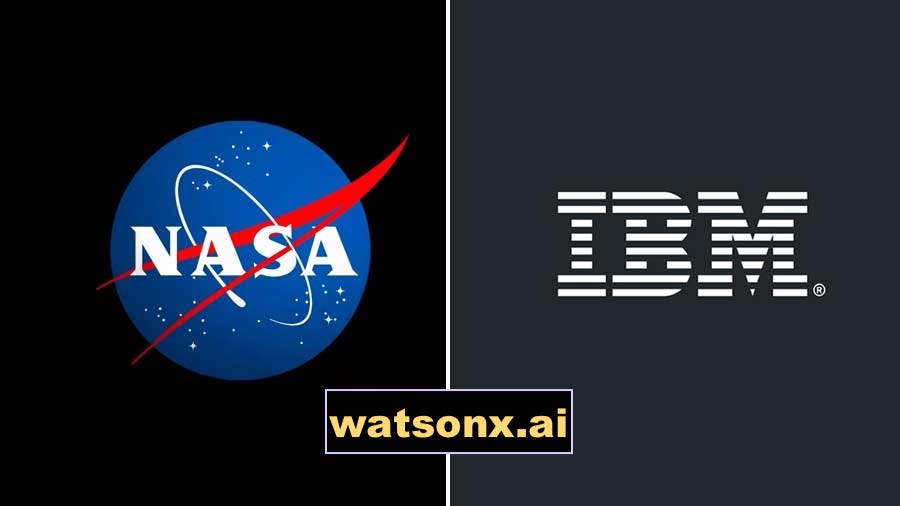
- 22 Dec 2023
Why is it in the News?
At the recent COP28, NASA and IBM announced that an Artificial Intelligence (AI) tool called watsonx.ai would be available on the open-source AI platform Hugging Space.
What is watsonx.ai?
- Watsonx.ai is a collaborative Artificial Intelligence tool developed by IBM and NASA.
- Its primary function is to enable users to monitor Earth from space, assessing past environmental changes and offering predictions about future occurrences.
- User-Friendly Interface: The tool is designed for simplicity, requiring users to select a location and a date.
- Watsonx.ai then highlights changes in floodwater, reforestation efforts, and other pertinent factors.
Functionality:
- Watsonx.ai is built on a foundation model trained on a diverse set of uncategorized data, allowing it to extrapolate information from one context to another.
- NASA provides datasets in the form of satellite images, and IBM developed the foundation model to interpret these visual inputs.
- The model's training involves comprehending visual sequences over time by reconstructing images with blank areas. This process enhances its ability to understand the connections between photos.
- Adjustments were made to the model for specific tasks such as segmenting and categorizing photos.
Additional Components:
- Watsonx.data: A specialized data store optimized for governed data and AI workloads.
- It facilitates the scaling of AI workloads by leveraging the entire data landscape.
- Watsonx.governance: An end-to-end toolkit encompassing both data and AI governance. It aids clients in establishing responsible, transparent, and explainable AI workflows.
- The toolkit provides governance capabilities for model management throughout the AI lifecycle.
Psyche Mission (Indian Express)
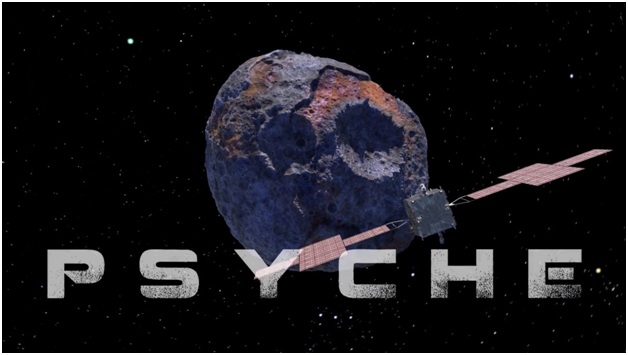
- 24 Nov 2023
Why is it in the News?
A NASA experiment on the Psyche spacecraft has beamed back a near-infrared laser that contains test data from almost 16 million kilometers away.
About the Psyche Mission:
- Psyche is a NASA mission to study a metal-rich asteroid ‘Psyche’, located in the main asteroid belt between Mars and Jupiter.
- The mission launched on October 13, 2023, from Kennedy Space Center and will arrive at Psyche in August 2029.
- The spacecraft will orbit the asteroid for about two years, studying its geology, composition, and magnetic field.
- Scientists believe that Psyche may be the exposed core of an early planet that never fully formed.
- If so, studying Psyche could provide important insights into the formation of our solar system.
- It is also the first in a series of NASA science missions to be the primary payload launched on a SpaceX Falcon Heavy rocket.
- The goals of the Psyche mission are to:
- Understand the composition and structure of a metallic asteroid.
- Determine how Psyche formed and evolved.
- Learn more about the formation of planetary cores.
- The Psyche spacecraft is a solar-powered spacecraft that uses Hall effect thrusters for propulsion.
- The spacecraft also carries a suite of scientific instruments, including:
- A magnetometer to measure Psyche's magnetic field.
- A spectrometer to measure the composition of Psyche's surface.
- A gamma-ray spectrometer to measure the abundance of elements on Psyche's surface.
Atmospheric Waves Experiment (Indian Express)
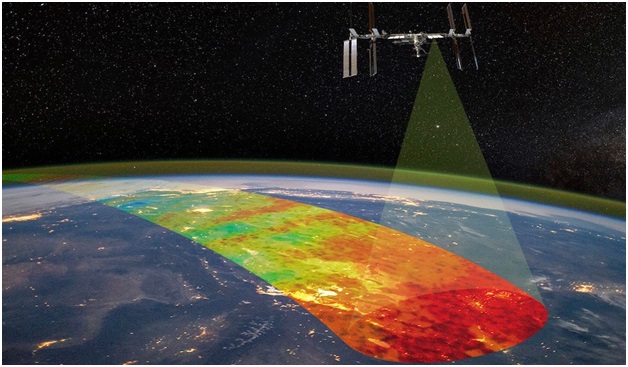
- 21 Nov 2023
Why is it in the News?
Atmospheric Waves Experiment is a first-of-its-kind NASA experimental attempt aimed at studying the interactions between terrestrial and space weather.
What is the Atmospheric Waves Experiment (AWE)?
- AWE is a first-of-its-kind NASA experimental attempt aimed at studying the interactions between terrestrial and Space weather.
- Planned under NASA’s Heliophysics Explorers Program, the $42 million mission will study the links between how waves in the lower layers of the atmosphere impact the upper atmosphere, and thus, Space weather.
- AWE will be launched and mounted on the exterior of the Earth-orbiting International Space Station (ISS).
- From the vantage point, it will look down at the Earth and record the colourful light bands, commonly known as airglow.
- It will try to understand the combination of forces that drive the Space weather in the upper atmosphere.
- “AWE could open a new window of study, wherein scientists are attempting to understand if Space weather is affected by terrestrial and bottom-up forces.
- It will measure the airglow at mesopause (about 85 to 87 km above the Earth’s surface), where the atmospheric temperatures dip to minus 100 degrees Celsius.
- At this altitude, it is possible to capture the faint airglow in the infrared bandwidth, which appears the brightest enabling easy detection.
- AWE will be able to resolve waves at finer horizontal scales than what satellites can usually see at those altitudes, which is part of what makes the mission unique.
- The health of the ionosphere, whose lower layers sit at the edge of Space, is important for maintaining seamless communication.
- It is still not fully understood if the ionosphere is affected by the transient events or intense perturbations resulting from hurricanes or tornadoes.
- It was expected to launch in the month of August 2022, but the fresh launch is planned for later this month.
Wasp-107b (TOI)
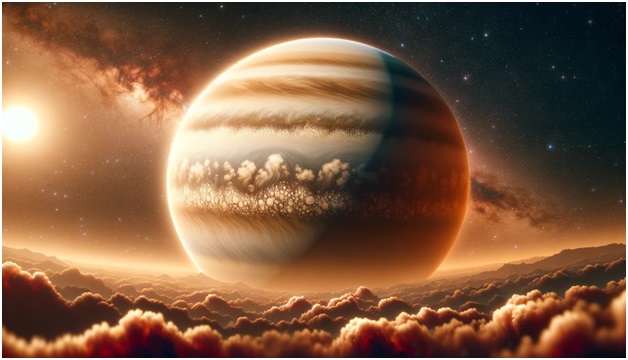
- 17 Nov 2023
Why in the News?
In its latest discovery, NASA's James Webb Space Telescope has discovered a planet "Wasp-107b" where specks of sand fall as rain.
What is “Wasp-107b”?
- WASP-107b is a warm exoplanet with Neptune’s mass and Jupiter’s radius.
- This makes it ‘fluffy’ compared to the giant gas planets in our Solar System.
- This unusual size-to-mass ratio has given astronomers a unique opportunity to probe its atmosphere roughly 50 times deeper than more dense planets like Jupiter.
- This gas giant, often referred to as a "super-Neptune," holds several remarkable characteristics that set it apart from other known exoplanets.
Key Characteristics of WASP-107b:
- Size and Mass: WASP-107b is roughly the size of Jupiter, but with only about 12% of Jupiter's mass.
- This makes it one of the least dense exoplanets ever discovered.
- Orbit and Proximity: WASP-107b orbits its host star, WASP-107, very closely, completing an orbit in just 5.7 days.
- It is located about 200 light-years from Earth in the constellation Virgo.
- Sand Rain: WASP-107b exhibits a unique water cycle similar to Earth's, but with a peculiar twist: instead of water droplets, the planet experiences sand rain.
- These sand grains, composed of silicates, rise from lower atmospheric levels and condense into clouds before falling back down.
- Atmosphere: WASP-107b possesses a puffy atmosphere, likely due to its low density.
- In 2018, scientists using the Hubble Space Telescope detected helium in its atmosphere, marking the first detection of this element in an exoplanet's atmosphere.
- Potential for Atmospheric Characterization: WASP-107b's large size and proximity to its star make it a promising target for future atmospheric characterization studies.
- Scientists hope to glean more insights into the composition and dynamics of its atmosphere.
Aurora (Indian Express)

- 10 Nov 2023
Why in the News?
Recently, NASA shared this incredible image of an aurora taken from the International Space Station.
What is Aurora?
- An aurora is a natural light display that shimmers in the sky.
- They are only visible at night, and usually only appear in lower polar regions.
- Auroras come in colors like blue, red, yellow, green, and orange.
- They're mostly visible near the Arctic and Antarctic Circles, known as the aurora borealis and aurora australis, respectively.
- These natural light shows occur when the solar wind from the sun meets Earth's magnetic field, creating a beautiful halo of light around the poles.
- This collision between solar wind ions and Earth's atmosphere atoms leads to stunning auroras.
- Their color depends on altitude and the atoms involved.
- Red comes from oxygen ions higher up, while the familiar green-yellow hues arise from interactions at lower altitudes.
- Sometimes, reddish and bluish tints appear, created by ions colliding with nitrogen atoms.
- The most active auroras happen when the solar wind is strongest, affected by solar weather changes, which follow an 11-year cycle.
- Equinoxes and magnetic storms can cause auroras to be seen even in mid-latitudes, affecting communication signals and occasionally causing disruptions.
- Auroras are a natural spectacle, painted by the collision of solar wind and Earth's atmosphere, creating these dancing lights in the night sky.
Euclid Mission (NASA)
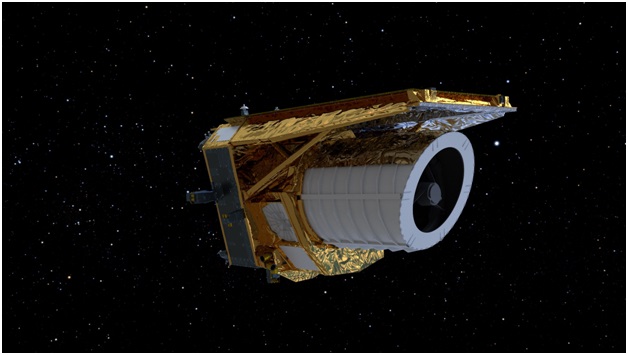
- 07 Nov 2023
Why in the News?
The Euclid mission, which will investigate the mysteries of dark matter and dark energy, released its first five science images recently.
About Euclid Mission:
- Euclid is a European mission, built and operated by European Space Agency (ESA), with contributions from NASA.
- Euclid is designed to give important new insights into the "dark side" of the universe -- namely dark matter and dark energy, both thought to be key components of our cosmos.
- It was launched from Cape Canaveral, Florida, (USA) on 1 July 2023 and the launch vehicle used was ‘SpaceX Falcon 9’.
- The mission derives its name from Euclid of Alexandria, an ancient Greek mathematician from around 300 BC, who laid the foundations of geometry.
- Euclid Mission Objective: The primary goal of the Euclid mission is to create a three-dimensional map of the universe, with time as the third dimension.
- This will be achieved by observing billions of galaxies, extending up to 10 billion light-years away, and covering over a third of the celestial sphere.
- Euclid will explore how the Universe has expanded and how structure has formed over cosmic history, revealing more about the role of gravity and the nature of dark energy and dark matter.
- The Euclid Consortium – consisting of more than 2,000 scientists from 300 institutes in 13 European countries, the U.S., Canada, and Japan – is responsible for providing the scientific instruments and scientific data analysis.
- NASA provided the detectors of the Near-Infrared Spectrometer and Photometer, NISP.
- Euclid is a medium-class mission in ESA’s Cosmic Vision Programme.
Lucy Mission (NASA) (Indian Express)
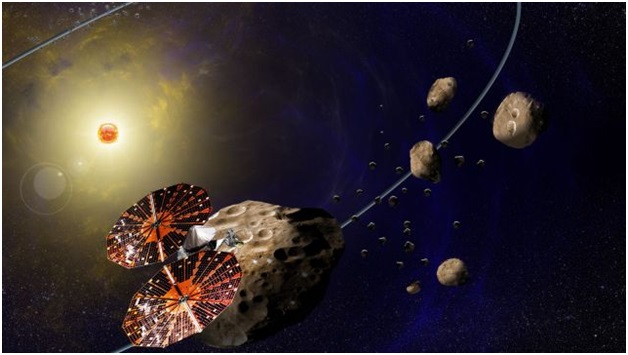
- 04 Nov 2023
Why in the News?
Recently NASA's Lucy mission has discovered that the asteroid Dinkinesh is actually a binary system of two asteroids.
About Lucy Mission:
- The Lucy Mission is a NASA space probe designed to explore the Trojan asteroids.
- These are the asteroids that share an orbit with Jupiter around the Sun.
- It's on a twelve-year journey to visit eight different asteroids and the entire mission costs around $981 million.
- It was launched on October 16, 2021, from Cape Canaveral Space Force Station or Kennedy Space Centre in Florida.
- The Lucy Mission is named for the fossilized skeleton of a human ancestor, which was named for the Beatles song "Lucy in the Sky with Diamonds."
- The mission's scientists hope that Lucy will help them to better understand our own origins, just as the Lucy fossil helped us to better understand our evolutionary history.
- The Lucy spacecraft is equipped with a suite of instruments that will be used to study the asteroids it encounters. These instruments include:
- A high-resolution visible camera
- A near-infrared spectrometer
- A thermal emission spectrometer
- A dust detector
- A radio occultation instrument
- Lucy's mission will provide new insights into the diversity of the Trojan asteroids, their formation, and their role in the early solar system.
- The mission will also test new technologies for deep space exploration, such as a solar-powered propulsion system and a terminal tracking system.
- It made its first gravity assist from Earth on October 16, 2022, and on November 1, 2023, it flew by its first asteroid, Dinkinesh, a binary asteroid in the main belt.
- Lucy will make another gravity assist from Earth in 2024, and in 2025, it will fly by the inner main-belt asteroid 52246 Donaldjohanson.
NASA all set to launch of PACE mission to study air quality, key climate factors and more (NASA)
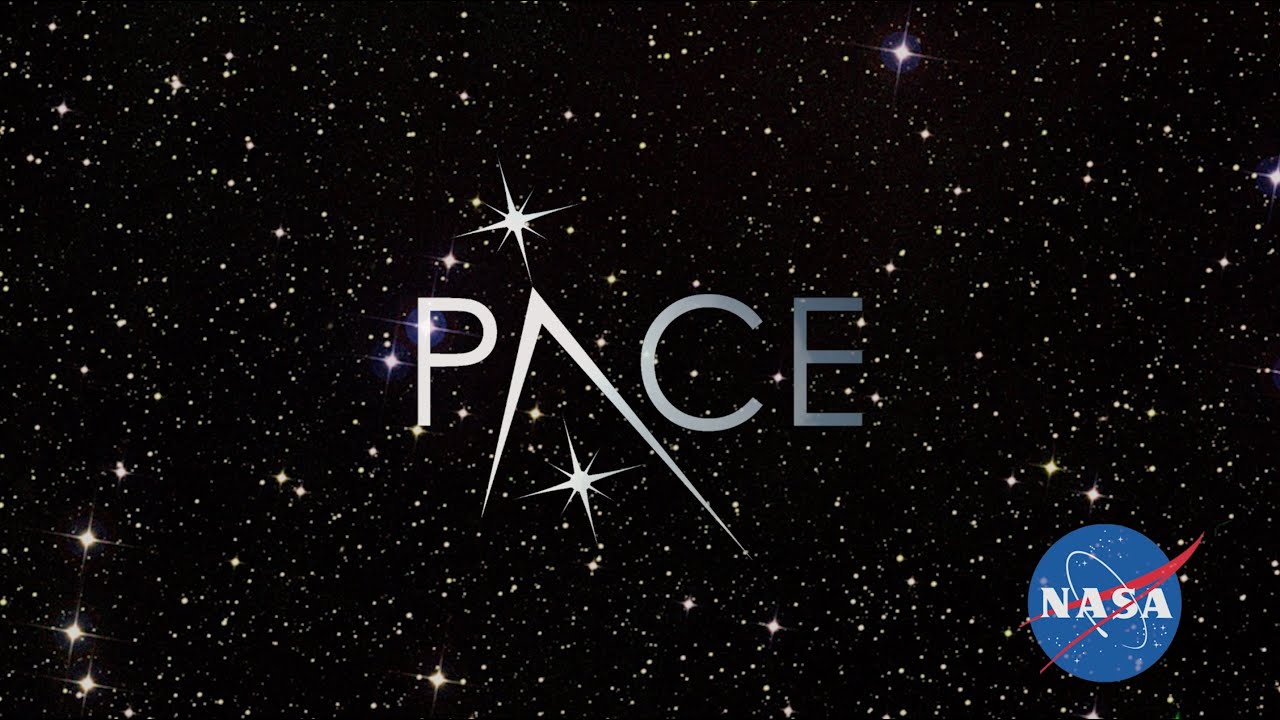
- 15 Dec 2023
Why is it in the News?
NASA is ready to enhance our understanding of Earth’s atmosphere with the upcoming Plankton, Aerosol, Cloud, Ocean Ecosystem (PACE) mission, scheduled for launch in early 2024.
What is NASA's PACE Mission?
- The mission will leverage advanced polarimeters to investigate the intricate interactions of light, aerosols, and clouds, enhancing our understanding of their impact on both air quality and climate.
- Beyond aerosol analysis, the PACE mission will delve into the study of ocean colour.
- At its core, the Ocean Colour Instrument (OCI) serves as the primary science instrument for PACE, designed to measure the ocean's colour across a spectrum ranging from ultraviolet to shortwave infrared.
- The mission includes two polarimeters:
- The Spectro-polarimeter for Planetary Exploration (SPEXone) and
- The Hyper Angular Research Polarimeter (HARP2)
- Working in tandem, these instruments offer complementary spectral and angular sampling, ensuring polarimetric accuracy and extensive spatial coverage.
- This integrated approach aims to deliver enhanced atmospheric correction and a comprehensive dataset on aerosols and clouds, surpassing the capabilities of OCI alone.
- The collaborative payload of OCI, SPEXone, and HARP2 is poised to achieve significant breakthroughs in aerosol-cloud-ocean research.
What are Aerosols and their Effect?
- Aerosols are comprised of liquid or solid particles suspended in a gaseous or liquid medium.
- In the atmosphere, these particles are predominantly found in the lower layers (< 1.5 km) since aerosol sources are terrestrial.
- However, specific aerosols may extend into the stratosphere, particularly those ejected by volcanoes at high altitudes.
- Sources of Aerosols:
- Natural Sources: Generated from breaking waves (sea salt), wind-blown mineral dust from the surface, and volcanic emissions.
- Anthropogenic Aerosols: These include sulphate, nitrate, and carbonaceous aerosols, primarily originating from fossil fuel combustion.
- Effects of Aerosols:
- Impact on Atmospheric Chemistry.
- Reduction of Visibility.
- Significance for Air Quality and Human Health: Aerosols can adversely affect the heart and lungs.
- Role as Nuclei: Serve as nuclei for cloud droplets or ice crystals in ice clouds.
Voyager 2 Spacecraft (HT)
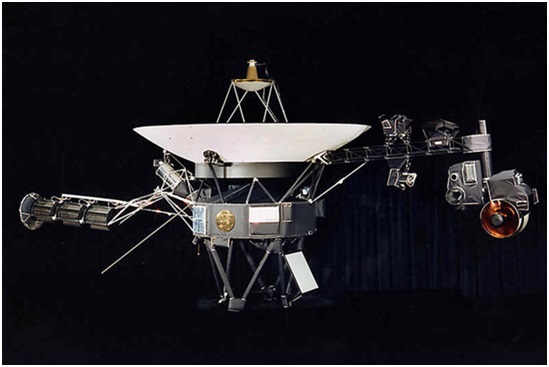
- 31 Jul 2023
Why in the News?
NASA’'s Voyager 2 spacecraft, which is venturing through space between stars, faces communication problems due to antenna misalignment. .
About Voyager 2 Spacecraft:
- Voyager 2 is an iconic interplanetary spacecraft launched by NASA on August 20, 1977, with the primary objective of exploring the outer planets of our solar system.
- It is part of the Voyager program, and along with its twin, Voyager 1, it has provided invaluable insights into the distant regions of our cosmic neighborhood.
- The spacecraft is equipped with a suite of scientific instruments to study various aspects of the planets it encounters, including their atmospheres, magnetic fields, and planetary surfaces.
- Voyager 2 successfully conducted close flybys of Jupiter in 1979, Saturn in 1981, Uranus in 1986, and Neptune in 1989, becoming the first and only spacecraft to visit these four giant gas planets.
- Beyond its initial mission, Voyager 2 continues to be operational and remains in communication with Earth, traveling at an impressive speed of approximately 34,000 miles per hour (55,000 kilometers per hour).
- It has since left the heliosphere, the region influenced by the Sun's magnetic field, and entered interstellar space, becoming the second human-made object to do so after Voyager 1.
- Throughout its journey, Voyager 2 has provided a wealth of data and discoveries about the outer planets and their moons, as well as valuable information about the space environment outside the solar system.
- It has captured breathtaking images of planetary systems, revealing the beauty and complexity of the outer planets and their fascinating moons.
- The spacecraft continues to be a remarkable testament to human ingenuity and curiosity as it ventures farther into the cosmos, providing us with an enduring legacy of exploration and knowledge about our celestial neighbors.
NASA-ISRO SYNTHETIC APERTURE RADAR (NISAR) (TOI)
- 29 Oct 2023
What is the News ?
The 'NASA-ISRO Synthetic Aperture Radar' (NISAR) is set to enable the investigation of how changes in Earth's forest and wetland ecosystems affect the worldwide carbon cycle and exert an influence on climate change.
Facts About:
- NASA and ISRO collaborated to develop the Low Earth Orbit (LEO) observatory known as NISAR.
It's about the size of an SUV and weighs 2,800 kilograms.
- It is a dual-frequency imaging radar satellite, having both L-band and S-band synthetic aperture radar (SAR) instruments.
- The first satellite mission to measure variations in the surface of our planet will be NISAR, which will use two distinct radar frequencies (L-band and S-band).
No matter the weather, SAR can gather data day or night and penetrate clouds to gather information.
- NASA has contributed GPS, an L-band radar, a payload data subsystem, and a high-capacity solid-state recorder for data storage.
ISRO on the other hand supplied the S-band radar, as well as the GSLV launch system and spacecraft.
- Additionally, it has a sizable 39-foot stationary antenna reflector with an upward-facing feed on the instrument structure that will be used to focus "the radar signals emitted and received."
The reflector is constructed of gold-plated wire mesh.
- The mission's objectives are to measure the dynamic surfaces, ice masses, and changing ecosystems of Earth in order to gather data on groundwater, biomass, natural hazards, and sea level rise.
- NISAR is going to perform global 12-day regular observations of Earth's land and ice-covered surfaces during ascending and descending passes.
NANCY GRACE ROMAN SPACE TELESCOPE (NASA)
- 26 Oct 2023
What is the News ?
NASA is preparing to use its Nancy Grace Roman Space Telescope to take humanity's deepest-ever look into the heart of our Milky Way Galaxy.
Facts About:
- The Nancy Grace Roman Space Telescope will offer one of the deepest views into the heart of the Milky Way galaxy.
Its mission includes monitoring hundreds of millions of stars to detect various celestial objects like planets, distant stars, icy objects in our solar system, black holes, and more.
- It will likely discover the farthest-known exoplanet, opening up new possibilities in the search for other worlds.
- Time-domain astronomy is a significant focus, studying how the universe changes over time, and Roman contributes to this field.
- The Galactic Bulge Time-Domain Survey will concentrate on the Milky Way, using infrared vision to see through dust clouds in the galaxy's central region.
The survey will involve taking images every 15 minutes around the clock for about two months, repeated six times over Roman's five-year primary mission.
- Astronomers anticipate finding over a thousand planets, including some within their host stars' habitable zones.
- It can detect "rogue" worlds that don't orbit stars, providing insights into planetary system formation.
- The mission will also identify brown dwarfs and help explore the boundary between planet and star formation.
- It is expected to spot neutron stars, stellar-mass black holes, Kuiper belt objects, and conduct stellar seismology studies on a million giant stars.
The telescope's broad view of space allows for a new view of an ever-changing universe.
- The Nancy Grace Roman Space Telescope is managed by NASA's Goddard Space Flight Center with participation from several other institutions and partners.
